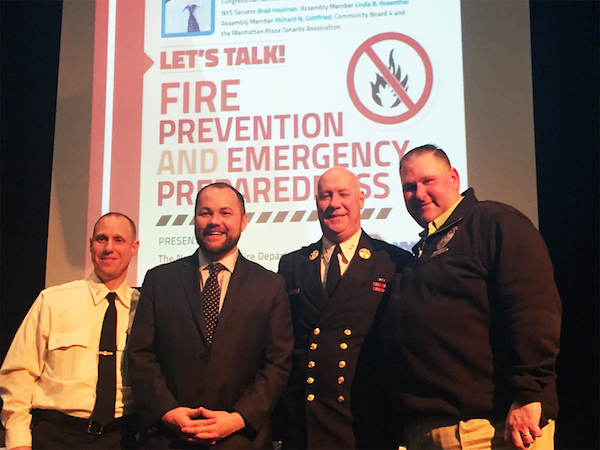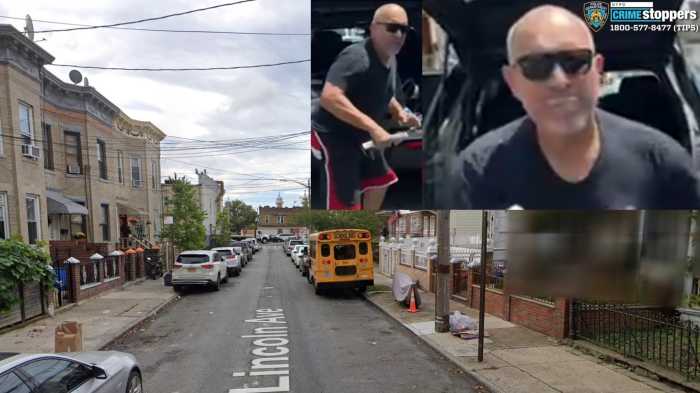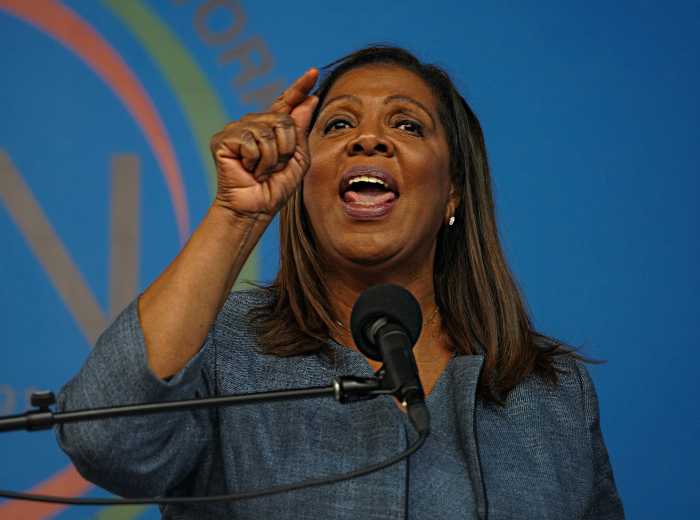
BY DENNIS LYNCH | Locals got a crash course on fire safety and emergency preparedness courtesy the fire department and the city’s Office of Emergency Management (OEM) on Monday night. Residents learned how to prepare themselves for either a fire or a disaster on the scale of Hurricane Sandy, as well as how to handle themselves in emergency situations.
Councilmember Corey Johnson, who sponsored the event as part of his “Let’s Talk” series, opened with remarks, then handed the mic off to FDNY Deputy Assistant Chief Michael Gala, who gave the crowd of around 100 people the lowdown on what some of the main fire safety issues people face.
One of his most important points was that the construction of your building changes what you should do in the case of a fire. If you live in a non-fireproof building (typically under 75 feet), you’ll want to look for your traditional ways out — fire escapes and stairwells. But if you live in a modern building above 75 feet, it’s going to be fireproof, so you want to stay in your apartment and close the door, he said (see fdnysmart.org/building-type for details).
“Do not leave your apartment,” Gala said. If you have no smoke or no fire in your apartment, stay in your apartment and call 911.”
If there is smoke coming in through the cracks around the door, stuff them with towels or seal them with tape.
Those high-rise buildings must have two stairwells. The FDNY will use one of them to evacuate, and one of them to “attack” the fire. The latter will have opened doors and so it can fill with smoke, but you won’t necessarily know which one is which. Gala said that many times firefighters find people passed out in their attack stairwells from smoke because they were trying to get out of the building.
Penn South resident Donna Lamb said she had no idea that she was supposed to stay in her apartment in her fireproof building.
“I didn’t know how important it is to stay in my apartment and wait until they tell you what stairwell they want you to evacuate out of. Just that alone was completely new knowledge for me,” she said. “I thought the whole idea was to get out by any means necessary.”
All Housing Authority buildings are fireproof — and generally speaking, buildings with fire escapes are not fireproof.
OEM Deputy Commissioner of Operations Frank McCarton followed Gala with some preparedness pointers. He suggested everyone pack a small bag with some emergency essentials, including a flashlight, a radio, medications (if necessary), toothpaste, batteries, and a facemask among other items. Click here for more info on compiling a “Go Bag.”
McCarton also suggested you create a plan with your family and know your neighbors, because they might need help in an evacuation scenario too. And, as he put it, “If we ask you leave, leave.”
FDNY Lieutenant Michael Kozo followed with some more detailed home fire safety tips. Electrical fires are the biggest cause of fire-related deaths in the city, he said. To prevent them, you should turn off space heaters and electric blankets when you go to bed.
You should use surge protected power strips, because unprotected strips can melt when too much is plugged in. Similarly, “you get what you pay for” with extension cords — go for a gauge with a low number (which indicates a thicker wire) and cords with thicker insulation. They should only be used temporarily.
If you don’t have a fire extinguisher, keep some baking soda in your kitchen outside the refrigerator and someplace you can reach in the case of a stovetop grease fire, which you absolutely cannot put out with water, unless you want to see some deadly fireworks.
Kozo suggested getting one combination smoke and carbon monoxide detector for each floor of your home, and one smoke detector for each bedroom. New detectors don’t have replaceable batteries anymore, they have integrated batteries that last about 7-10 years, so you just test them once per month.
He also said candles need to go out when you leave a room and suggested moving to electric candles if you’re the forgetful type.
“If you constantly find yourself a half hour away from your apartment asking yourself if you blew that candle out, its probably time to go with electric candles,” Kozo said.
They ended the talk with a question and answer session moderated by Johnson. The councilmember said his biggest takeaway was about preparedness.
“I think the biggest point to make is that you have to have a plan and you have to know your plan ahead of time,” Johnson said. “And you have to have working smoke detectors and carbon monoxide detectors; those are two things that are the biggest lifesavers if, in fact, a fire hits your building or apartment.”
Johnson also said his office could help coordinate with local groups and companies if they wanted to bring in city fire safety and preparedness experts for talks in the district. Contact his office at 212-564-7757 or by email at district3@council.nyc.gov.






























